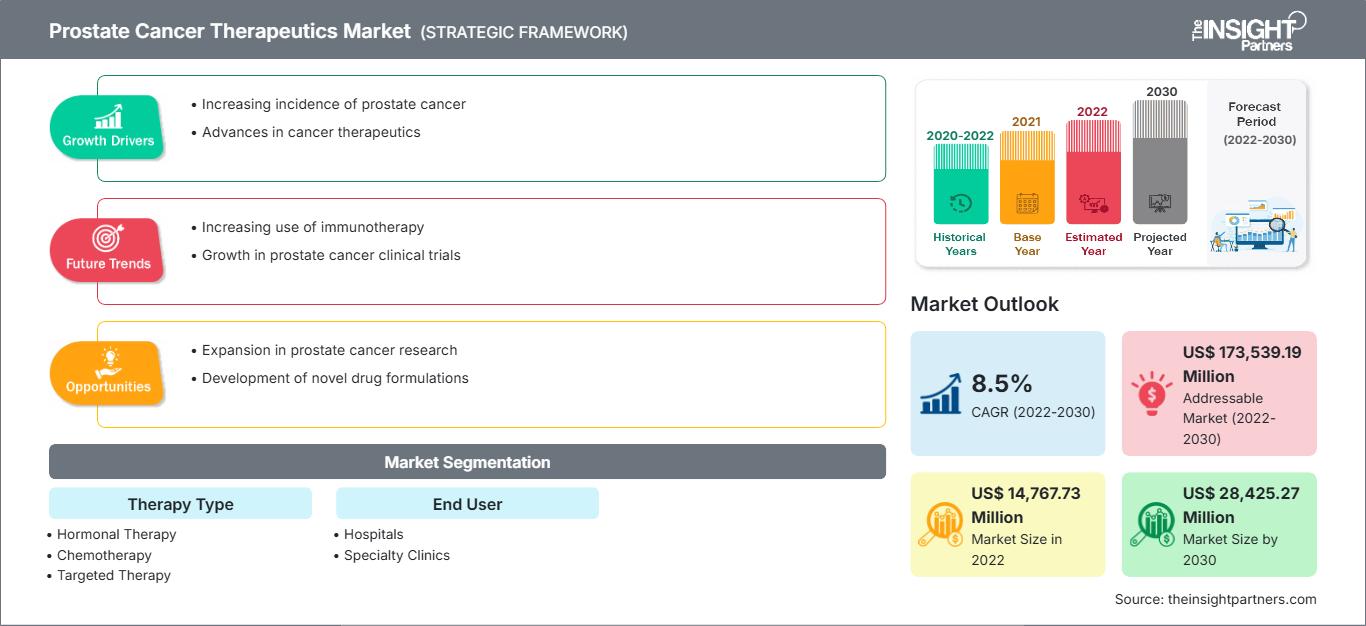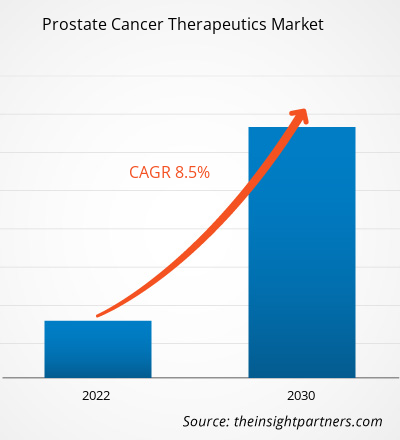[Rapporto di ricerca] Si prevede che il mercato delle terapie per il cancro alla prostata crescerà da 14.767,73 milioni di dollari nel 2022 a 28.425,27 milioni di dollari entro il 2030; si prevede che registrerà un CAGR dell'8,5% dal 2022 al 2030.
Approfondimenti di mercato e punto di vista degli analisti:
Le dimensioni del mercato delle terapie per il cancro alla prostata si stanno espandendo con le crescenti attività di ricerca e sviluppo per introdurre nuovi composti farmacologici, il crescente numero di casi di cancro alla prostata e il crescente sostegno governativo alla diagnostica del cancro alla prostata. Inoltre, la disponibilità di prodotti avanzati da parte degli operatori del mercato stimola la crescita del mercato. Nel gennaio 2023, BDR Pharmaceutical ha lanciato una versione generica di Apalutamide, utilizzata per il trattamento del cancro alla prostata in India. Il farmaco è lanciato con il marchio APATIDE ed è prescritto per il trattamento del carcinoma prostatico non metastatico resistente alla castrazione e del carcinoma prostatico metastatico sensibile alla castrazione.
Fattori di crescita e sfide:
Il carcinoma prostatico è uno dei problemi di salute più comuni negli uomini, soprattutto negli uomini anziani dai 50 anni in su. Il carcinoma prostatico è più comune negli uomini obesi e con una storia familiare di carcinoma prostatico. Il carcinoma prostatico è una minaccia silenziosa, poiché spesso si sviluppa senza sintomi evidenti. Pertanto, la diagnosi precoce di questo tumore non è così facile. La maggior parte dei tumori prostatici ha origine nella regione periferica della ghiandola prostatica. Affinché i sintomi diventino evidenti, il tumore deve raggiungere dimensioni tali da esercitare pressione sull'uretra; in alcuni casi, il dolore osseo dovuto alle metastasi potrebbe essere il sintomo iniziale del carcinoma prostatico avanzato. Tuttavia, qualsiasi individuo di età pari o superiore a 50 anni che presenti sintomi del tratto urinario inferiore, disfunzione erettile, orematuria dovrebbe considerare la possibilità di cancro alla prostata. Il cancro alla prostata è la quinta causa di morte per cancro tra gli uomini in tutto il mondo e il secondo tumore più comunemente diagnosticato. Sebbene si sia registrata una diminuzione dell'incidenza del cancro alla prostata dal 2000, si è registrato un aumento dell'incidenza del cancro alla prostata in fase avanzata a partire dal 2010. I tassi di incidenza e mortalità del cancro alla prostata variano notevolmente. I paesi sviluppati presentano generalmente un'incidenza più elevata di cancro alla prostata, ma una mortalità inferiore. Il rischio di cancro alla prostata negli Stati Uniti è quasi quattro volte superiore al rischio globale. Secondo Novartis AG, nel 2020 sono stati segnalati in tutto il mondo circa 1,4 milioni di nuovi casi di cancro alla prostata e circa 375.000 decessi per cancro alla prostata. Il crescente numero di casi di cancro alla prostata in tutto il mondo e il basso tasso di diagnosi del cancro alla prostata alimentano la crescita del mercato delle terapie per il cancro alla prostata.
Personalizza questo rapporto in base alle tue esigenze
Potrai personalizzare gratuitamente qualsiasi rapporto, comprese parti di questo rapporto, o analisi a livello di paese, pacchetto dati Excel, oltre a usufruire di grandi offerte e sconti per start-up e università
Mercato delle terapie per il cancro alla prostata: Approfondimenti strategici

- Ottieni le principali tendenze chiave del mercato di questo rapporto.Questo campione GRATUITO includerà l'analisi dei dati, che vanno dalle tendenze di mercato alle stime e alle previsioni.
Potrai personalizzare gratuitamente qualsiasi rapporto, comprese parti di questo rapporto, o analisi a livello di paese, pacchetto dati Excel, oltre a usufruire di grandi offerte e sconti per start-up e università
Mercato delle terapie per il cancro alla prostata: Approfondimenti strategici

- Ottieni le principali tendenze chiave del mercato di questo rapporto.Questo campione GRATUITO includerà l'analisi dei dati, che vanno dalle tendenze di mercato alle stime e alle previsioni.
Segmentazione e ambito del report:
Il mercato delle terapie per il cancro alla prostata è segmentato in base al tipo di terapia, all'utente finale e all'area geografica. Il mercato delle terapie per il cancro alla prostata, per tipo di terapia, è segmentato in terapia ormonale, chemioterapia, immunoterapia, terapia mirata e altre. Il mercato delle terapie per il cancro alla prostata, per utente finale, è segmentato in ospedali, cliniche specialistiche e altre. In base all'area geografica, il mercato delle terapie per il cancro alla prostata è segmentato in Nord America (Stati Uniti, Canada e Messico), Europa (Regno Unito, Germania, Francia, Italia, Spagna e resto d'Europa), Asia-Pacifico (Cina, Giappone, India, Corea del Sud, Australia e resto dell'Asia-Pacifico), Medio Oriente e Africa (Emirati Arabi Uniti, Arabia Saudita, Sudafrica e resto del Medio Oriente e Africa) e Sud-Est asiatico. America Centrale (Brasile, Argentina e resto dell'America meridionale e centrale).
Analisi segmentale:
Il mercato delle terapie per il cancro alla prostata, per tipologia di terapia, è segmentato in terapia ormonale, chemioterapia, immunoterapia, terapia mirata e altre. Nel 2022, il segmento della terapia ormonale ha detenuto la quota di mercato maggiore dopo la chemioterapia e si prevede che lo stesso segmento registrerà il CAGR più elevato dal 2022 al 2030. La chemioterapia è considerata un trattamento importante per il cancro alla prostata. In questa terapia, i farmaci distruggono le cellule cancerose, nuove o esistenti, nei polmoni. La chemioterapia per il cancro alla prostata metastatico può alleviare i sintomi. Può anche contribuire a ridurre il cancro e migliorare la qualità della vita. Il docetaxel (Taxotere) è considerato lo standard di cura nella chemioterapia per il cancro alla prostata nei pazienti resistenti alla terapia ormonale. La FDA ha inoltre approvato il farmaco chemioterapico cabazitaxel (Jevtana) per il trattamento del carcinoma prostatico resistente alla castrazione. Viene utilizzato anche per i pazienti affetti da carcinoma prostatico metastatico in crescita durante l'assunzione di docetaxel.
Analisi regionale:
Il mercato delle terapie per il cancro alla prostata è segmentato geograficamente in Nord America, Europa, Asia-Pacifico, Medio Oriente e Africa e America meridionale e centrale. Il Nord America contribuisce maggiormente alla crescita del mercato globale delle terapie per il cancro alla prostata. Si prevede che l'Asia-Pacifico registrerà il CAGR più elevato nel mercato delle terapie per il cancro alla prostata dal 2022 al 2030. La crescita del mercato delle terapie per il cancro alla prostata negli Stati Uniti è trainata principalmente dalla crescente incidenza di casi di cancro alla prostata, dal lancio di nuovi prodotti e dalle iniziative governative. Nel giugno 2023, Lynparza (olaparib) di AstraZeneca e MSD, in combinazione con prednisone o prednisolone e abiraterone, è stato approvato negli Stati Uniti per il trattamento di pazienti adulti con sospetto carcinoma prostatico metastatico resistente alla castrazione (mCRPC) con mutazione BRCA deleteria (BRCAm). Inoltre, nel novembre 2023, la FDA ha approvato enzalutamide, un prodotto prodotto da Astellas Pharma US, Inc. Il prodotto è utilizzato per il trattamento del carcinoma prostatico non metastatico sensibile alla castrazione (nmCSPC) con recidiva biochimica ad alto rischio di metastasi (BCR ad alto rischio).
Approfondimenti regionali sul mercato delle terapie per il cancro alla prostata
Le tendenze regionali e i fattori che influenzano il mercato delle terapie per il cancro alla prostata durante il periodo di previsione sono stati ampiamente spiegati dagli analisti di The Insight Partners. Questa sezione illustra anche i segmenti e la geografia del mercato delle terapie per il cancro alla prostata in Nord America, Europa, Asia-Pacifico, Medio Oriente e Africa, America meridionale e centrale.
Ambito del rapporto di mercato sulla terapia del cancro alla prostata
| Attributo del rapporto | Dettagli |
|---|---|
| Dimensioni del mercato in 2022 | US$ 14,767.73 Million |
| Dimensioni del mercato per 2030 | US$ 28,425.27 Million |
| CAGR globale (2022 - 2030) | 8.5% |
| Dati storici | 2020-2022 |
| Periodo di previsione | 2022-2030 |
| Segmenti coperti |
By Tipo di terapia
|
| Regioni e paesi coperti | Nord America
|
| Leader di mercato e profili aziendali chiave |
|
Densità degli operatori del mercato delle terapie per il cancro alla prostata: comprendere il suo impatto sulle dinamiche aziendali
Il mercato dei farmaci per la terapia del cancro alla prostata è in rapida crescita, trainato dalla crescente domanda degli utenti finali, dovuta a fattori quali l'evoluzione delle preferenze dei consumatori, i progressi tecnologici e una maggiore consapevolezza dei benefici del prodotto. Con l'aumento della domanda, le aziende stanno ampliando la propria offerta, innovando per soddisfare le esigenze dei consumatori e sfruttando le tendenze emergenti, alimentando ulteriormente la crescita del mercato.

- Ottieni il Mercato delle terapie per il cancro alla prostata Panoramica dei principali attori chiave
Sviluppi del settore e opportunità future:
Di seguito sono elencate varie iniziative dei principali attori che operano nel mercato delle terapie per il cancro alla prostata:
- A marzo 2022, la FDA statunitense ha approvato Pluvicto di Novartis (lutezio Lu 177 vipivotide tetraxetano) per il trattamento di pazienti adulti affetti da un tipo di cancro alla prostata avanzato chiamato cancro alla prostata metastatico resistente alla castrazione positivo all'antigene di membrana prostatico specifico (mCRPC positivo al PSMA).
- Ad aprile 2023, la FDA ha concesso a Lantheus Holdings Inc e POINT Biopharma Global Inc la designazione fast track per 177Lu-PNT2002 per il trattamento del cancro alla prostata metastatico resistente alla castrazione (mCRPC positivo al PSMA). PNT2002 è un'innovativa terapia radiofarmaceutica a base di 177Lu mirata al PSMA che combina il ligando mirato al PSMA, PSMA-I&T e un radioisotopo beta-emittente 177Lu senza aggiunta di carrier per il trattamento del carcinoma prostatico metastatico resistente alla castrazione.
Panorama competitivo e aziende chiave:
Astella Pharma Inc, Johnson & Johnson Services Inc, Eli Lilly and Company, Bayer AG, Sanofi, Merck KGaA, AstraZeneca, Novartis AG, AbbVie e Bristol Myers Squibb sono tra i principali attori che operano nel mercato delle terapie per il cancro alla prostata. Questi attori di mercato si concentrano sul lancio di nuovi prodotti e sull'espansione geografica per soddisfare la crescente domanda dei consumatori in tutto il mondo e ampliare la loro gamma di prodotti nei portafogli specialistici. La loro presenza globale consente loro di servire un'ampia base di clienti, facilitando di conseguenza l'espansione del mercato.
- Analisi storica (2 anni), anno base, previsione (7 anni) con CAGR
- Analisi PEST e SWOT
- Valore/volume delle dimensioni del mercato - Globale, Regionale, Nazionale
- Industria e panorama competitivo
- Set di dati Excel
Report recenti
Rapporti correlati
Testimonianze
Motivo dell'acquisto
- Processo decisionale informato
- Comprensione delle dinamiche di mercato
- Analisi competitiva
- Analisi dei clienti
- Previsioni di mercato
- Mitigazione del rischio
- Pianificazione strategica
- Giustificazione degli investimenti
- Identificazione dei mercati emergenti
- Miglioramento delle strategie di marketing
- Aumento dell'efficienza operativa
- Allineamento alle tendenze normative




















 Ottieni un campione gratuito per - Mercato delle terapie per il cancro alla prostata
Ottieni un campione gratuito per - Mercato delle terapie per il cancro alla prostata